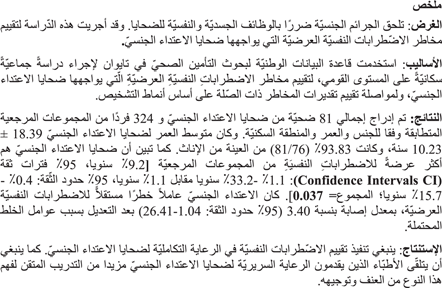No CrossRef data available.
Published online by Cambridge University Press: 22 March 2018
Sexual offenses cause harm to the victims’ physical and psychological functions. This study was conducted to evaluate the risk of incident psychiatric disorders in sexual assault victims. Taiwan’s National Health Insurance Research Database was used to conduct a nationwide population-based cohort study to assess the risk of incident psychiatric disorders in sexual assault victims and to further evaluate the respective risk estimates on the basis of diagnostic patterns. A total of 81 sexual assault victims and 324 controls matched by sex, age and residential area were included. The mean age of the sexual assault victims was 18.39 (sd 10.23) years, and 93.83% (76/81) of the sample were females. Sexual assault victims had a higher incidence density of psychiatric disorders than did the control group (9.2% per year, 95% confidence interval [CI] 1.1–33.2% per year v. 1.1% per year, 95% CI .4–15.7% per year; p=.037). Sexual assault was an independent risk factor for incident psychiatric disorders, with an incidence rate ratio of 3.40 (95% CI 1.04–26.41) after adjustment for potential confounding factors. Assessment of psychiatric disorders should be implemented in the integrative care of sexual assault victims. Physicians providing clinical care to the sexual assault victims should receive more all-round training to understand and manage this type of violence.
Objectif. Les agressions sexuelles ont un impact négatif sur les fonctions physiques et psychologiques des victimes. Cette étude a été menée pour évaluer le risque de troubles psychiatriques chez les victimes d’agression sexuelle à la suite de l’agression subie. Méthodes. La base de données nationale de la securité sociale de Taiwan a été utilisée pour mener une étude nationale sur la population afin d'évaluer le risque de troubles psychiatriques chez les victimes d’agression sexuelle et d'évaluer les risques respectifs sur la base des diagnostics. Résultats. Un total de 81 victimes d’agression sexuelle et 324 personnes témoins triées selon le sexe, l'âge et la zone résidentielle ont été inclus. L'âge moyen des victimes d’agression sexuelle était de 18,39 ± 10,23 ans, et 93,83% (76/81) de l'échantillon étaient des femmes. Les victimes d’agression sexuelle présentaient une densité d’incidence de troubles psychiatriques plus élevée que le groupe témoin [9,2% par année, intervalle de confiance à 95%: 1,1% -33,2% par année contre 1,1% par année, IC à 95%: 0,4% -15,7% par an; p=0,037]. L’agression sexuelle était un facteur de risque indépendant pour les troubles psychiatriques consequents, avec un rapport de taux d’incidence de 3,40 (IC à 95%: 1,04-26,41) après un ajustement des facteurs potentiels de confusion. Conclusion. L'évaluation des troubles psychiatriques devrait être mise en œuvre dans les soins des victimes d’agression sexuelle. Les médecins fournissant des soins cliniques aux victimes d’agression sexuelle devraient recevoir une formation plus complète pour comprendre et gérer ce type de violence.
Obietivo. Las ofensas sexuales causan daño a las funciones físicas y psicológicas de las víctimas. Este estudio se realizó para evaluar el riesgo de trastornos psiquiátricos incidentes en víctimas de agresión sexual. Metodos. La base de datos de investigación del seguro nacional de salud de Taiwán se utilizó para realizar un estudio de cohortes basado en la población a nivel nacional para evaluar el riesgo de trastornos psiquiátricos incidentes en víctimas de agresión sexual y evaluar las respectivas estimaciones de riesgo sobre la base de patrones de diagnóstico. Resultados. Se incluyeron un total de 81 víctimas de agresión sexual y 324 controles emparejados por sexo, edad y área residencial. La edad media de las víctimas de agresión sexual fue de 18.39±10.23 años, y el 93.83% (76/81) de la muestra fueron mujeres. Las víctimas de agresión sexual tenían una mayor densidad de incidencia de trastornos psiquiátricos que el grupo de control [9,2% por año, intervalo de confianza del 95% (IC): 1,1% -33,2% por año vs. 1,1% por año, IC 95%: 0,4% -15.7% por año; p=0.037]. La agresión sexual fue un factor de riesgo independiente para los trastornos psiquiátricos incidentes, con una tasa de incidencia de 3.40 (IC 95%: 1.04-26.41) después del ajuste por posibles factores de confusión. Conclusión. La evaluación de los trastornos psiquiátricos debe implementarse en el cuidado integral de las víctimas de agresión sexual. Los médicos que brindan atención clínica a las víctimas de agresión sexual deberían recibir más capacitación integral para comprender y manejar este tipo de violencia.
性犯罪會導致受害者的生理與心理功能的傷害。本研究為評估性侵害受害者之精神疾病發生率。
方法:以台灣全民健康保險資料庫建立以全國人口為基礎的世代研究,除探討性侵害受害者其精神障礙的發生率外,並進行風險模式評估。 結果:利用性別、年齡和居住地區進行配對共81名的性侵害受害者及324名的對照組。性侵害受害者的平均年齡為18.39±10.23 歲,其中有93.83%(76/81)為女性受害者。性侵害受害者精神障礙之年發生率高於對照組[9.2%,(95%信賴區間 (confidence interval, CI):1.1%–33.2%) vs. 1.1%, (95%信賴區間:0.4%–15.7%), p=0.037]。此外,在控制其他干擾因子後,性侵害為被害人精神障礙發生之獨立危險因子,發生率相對風險(incidence rate ratio)為3.40 (95% CI: 1.04-26.41)。 結論:精神障礙的評估應該在性侵害受害者的綜合治療中實施。為性侵害受害者提供臨床護理的醫師應該接受更全面的培訓,以了解和管理這種暴力類型。

